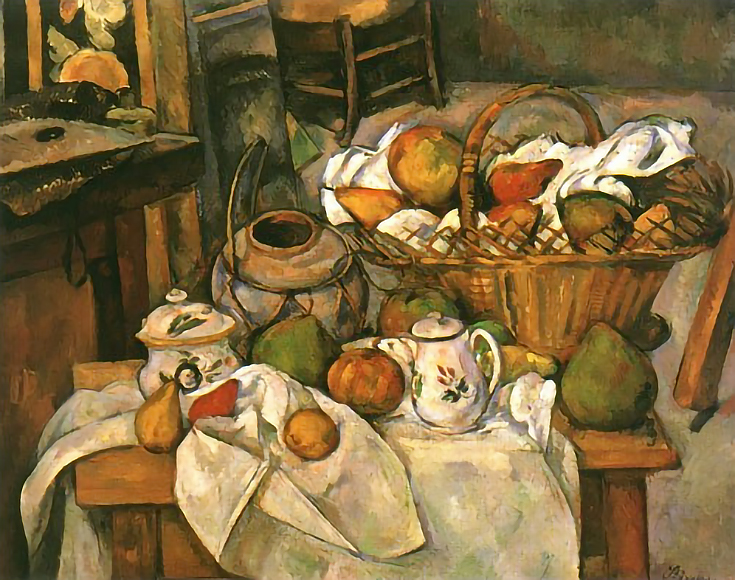10 Giuseppe Arcimboldo , Summer
Renaissance artist Giuseppe Arcimboldo was perhaps the first artist to use food to create a mosaic image, though his work was in paint, not made of food itself. This image, ‘Summer’, is part of a seasonal series and features a human profile made up of fruits and vegetables. His work had a surreal quality long before the advent of the Surrealist Art movement.
9 Salvador Dali. Lobster Phone.
Salvador Dalí produced this one of the most hilarious objects spawned by the Surrealist movement, his Lobster telephone 1936. This artwork was commissioned from the artist by the English poet and collector Edward James (1907-1984), a wealthy and eccentric patron who had inherited a vast English estate and fortune at the age of five, and who has been aptly described as 'virtually a present-day adumbration of the mad Ludwig of Bavaria, capaciously rich and richly capricious, only a little less than Ludwig in wealth and eccentricity.' A leading supporter of the Surrealists, James financed the early issues of the great Surrealist magazine Minotaure, and was also an active patron of the Belgian artist René Magritte, whom he met through Dalí. James spent a small fortune on Dalí himself, and eventually owned between forty and fifty of his best works, all from the 1930s (his greatest period).
8 Andy Warhol, Banana.
This image was used to grace the cover of Velvet Undergrounds Studio album with Nico. Pop art of which Andy Warhol was the most famous exponent made the use of everyday objects into works of art. His most famous being the Campbell soup cans series he also used fruit of which this is an example.
8 Claude Monet, Dejeuner sur l'herbe.
In 1863, Manet shocked the French public by exhibiting his Déjeuner sur l'herbe ("Luncheon on the Grass"). It is not a realist painting in the social or political sense, but it is a statement in favor of the artist's individual freedom. The shock value of a woman, naked as can be, casually lunching with two fully dressed men, which was an affront to the propriety of the time
7 Vermeer The Kitchen Maid
Painted in 1658. This subtle study of the kitchen maid at work shows a fascination of social study by Vemeer throughout his life.

Cezannes’s work entitled Still Life with Fruit Basket is a good example of a stylized representation of food in art.This magnificent tableau consists of a small wooden table draped in white cloth which supports a basket containing several apples and pears. One of the most notable modern elements in this painting is that the fruit basket appears sit both on the table AND on the floor behind it.
5 Van Gough, Still life with Quinces
Van Gogh painted this exceptional still life with fruit in 1887. He was not so much interested in depicting the fruit itself as in making a color study; specifically, of the color yellow. The composition is built up in related tones of ocher, yellow and brown, complemented with a little pink, red, green and a bit of blue. The frame, too, is painted in yellow and ocher. Van Gogh dedicated this bright, Impressionist work to his brother Theo, who was responsible for his introduction to modern art.
4 A1Sauce by Ralph Goings
This painting below by Ralph Goings entitled A-1 Sauce, is simply a collection of condiments on a table, illuminated by light from a window. Not a traditional romantic image, certainly, but the hues, shapes and composition all work together to create an undeniable mood that captures the viewer’s attention.
3 Franz Snyders, Still life with food
1579, Antwerp, Belgium - ca. 1657, Antwerp, Belgium School: Flemish
With the renaissance still lifes of tables of food, food was a natural subject for an artist--familiar, colorful, poseable (and still!), but these paintings conveyed a strong sense of the human-scale importance of a meal. The extravagance of commissioning an expensive, giant painting of a table overflowing with food must have been a really strong statement.
2 Renzo Valenti, Cherries an example of Photorealism
Photo-realism grew out of the Pop and Minimalism movements that preceded it. Like Pop artists, the Photo-realists were interested in breaking down hierarchies of appropriate subject matter by including everyday scenes of commercial life—cars, shops, and signage, for example. Also like them, the Photo-realists drew from advertising and commercial imagery. The Photo-realists’ use of an industrial or mechanical technique such as photography as the foundation for their work in order to create a detached and impersonal effect also had an affinity with both Pop and Minimalism. Yet many saw Photo-realism’s revival of illusionism as a challenge to the pared-down Minimalist aesthetic, and many perceived the movement as an attack on the important gains that had been made by modern abstract painting.
1 The Last Supper, Leonardo Da Vinci
The Last Supper ( Il Cenacolo or L'Ultima Cena) is a 15th century mural painting in Milan created by Leonardo Da Vinci for his patron Duke Ludovicio Sfroza and his duchess. It represents the scene ofThe Last Supper from the final days of Jesus as narrated in the Gospel of John 13:21, when Jesus announces that one of his Twelve Apostles would betray him. Perhaps the most famous painting in the world with food as one of its themes.
No comments:
Post a Comment